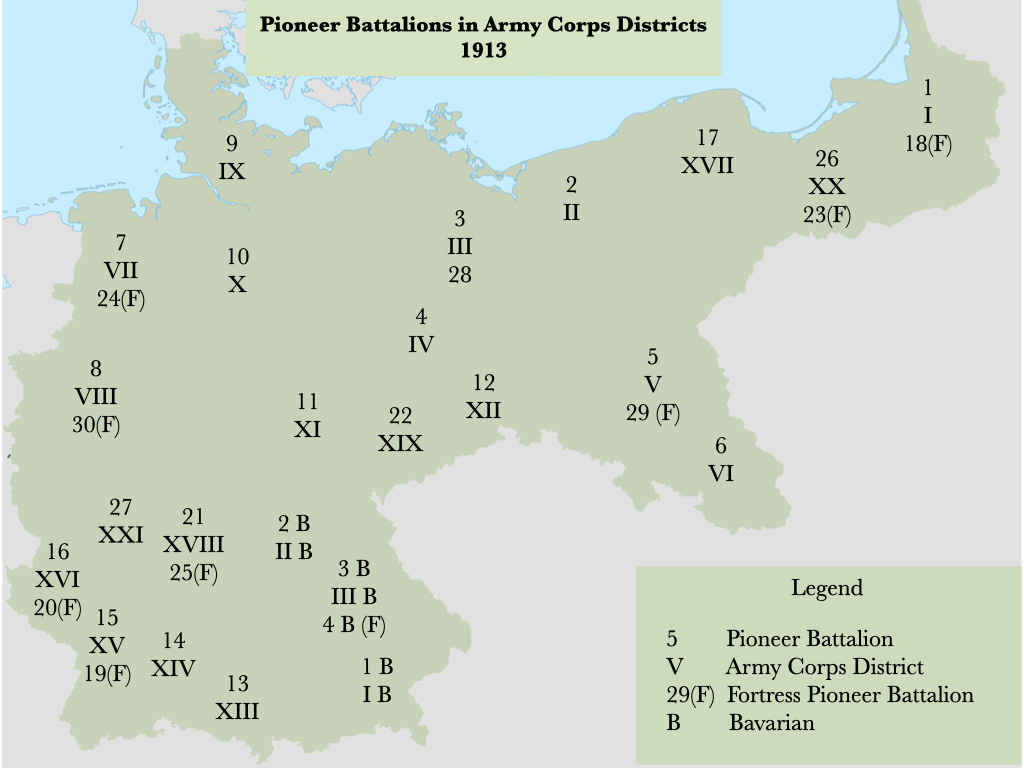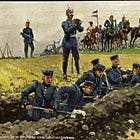On the two decades prior to the outbreak of the First World War, the armies of the German Empire maintained two types of combat engineer units: ordinary pioneer battalions and fortress pioneer battalions. Usually described simply as Pionier Bataillonen, ordinary pioneer battalions performed all of the engineer services that an army corps required to move, fight, and sustain itself on campaign. (The most important of these duties - the building of bridges and the running of ferries - enabled the army corps to cross rivers.) Fortress pioneer battalions (Festungs-Pionier Bataillonen), while also capable of the sort of work done by ordinary pioneer battalions, specialized in techniques for overcoming the defenses of permanent fortifications.
Until 1913, each of the 25 army corps of the German Empire possessed a single pioneer battalion of the ordinary type. Indeed, the strength of this connection was such that, in 21 of 25 cases, the ordinary pioneer battalion of an army corps bore the same number (or title) as its parent formation. Thus, the 10th Pioneer Battalion belonged to the X Army Corps and the Garde Pionier Bataillon belonged to the Guard Corps.1
The story of the fortress pioneers begins in 1893, when, in response to the Franco-Russian alliance of 1892 and the growing strength of French frontier fortifications, the Prussian Army raised 18th, 19th, and 20th Pioneer Battalions. (The Prussian authorities placed the 18th Pioneer Battalion in the fortress complex of Königsberg, the 19th Pioneer Battalion in the fortress complex of Strasbourg and the 20th Pioneer Battalion in the fortress complex of Metz.)
In the immediate aftermath of the Russo-Japanese War, the Prussian Army raised three additional fortress pioneer battalions. Bearing the numbers 23, 24, and 25, these were formed in years (1907, 1908, and 1909) when many German officers had begun to imagine scenarios in which combat engineers equipped with trench mortars, hand grenades, specialized explosives, and flame weapons would quickly cut through the obstacles that protected modern fortresses.
In 1912, the Bavarian Army created a fortress pioneer battalion of its own. As each of the three Bavarian army corps possessed an ordinary pioneer battalion of its own, this new unit received the number “4.” The following year, the Prussian Army formed two more fortress pioneer battalions, the 29th and 30th Pioneer Battalions.
In July of 1913, the raising of a second ordinary pioneer battalion for the III. Army Corps created an exception to the previously universal rule that each ordinary pioneer battalion belonged to a particular peacetime army corps. The new unit, the 28th Pioneer Battalion, served to provide pioneers for the Guard Reserve Corps, a formation that was to be assembled upon mobilization.
The exceptions to the rule that an ordinary pioneer battalion bore the same number as its parent army corps resulted from the use of the numbers 18, 19, and 20 to designate fortress pioneer battalions. Thus, when the XVIII, XIX, and XX Army Corps were formed, the numbers that their ordinary pioneer battalions would ordinarily have received had already been taken.








